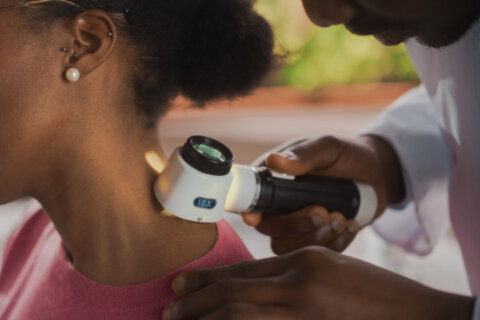You might not realize it, but your lungs and liver are connected in a very direct way. The liver manufactures a protein called alpha-1 antitrypsin, which is then used by the body to repair environmental damage that accumulates in the lungs. Therefore, in people with a normal production and distribution of AAt throughout the body, when they breathe in an irritant that damages cells in the lungs, the body uses AAt to repair the damage. Nice cooperation between liver and lungs, right?
But some people have a genetic mutation that prevents the AAt from exiting the liver where it’s made. Even though their livers are generating AAt — too much of it, actually — this protein gets stuck inside the liver and can’t travel to the lungs where it’s needed. This results in a condition called alpha-1 antitrypsin deficiency, and it can be a risk factor for the development of chronic obstructive pulmonary disease.
[See: 10 Questions Doctors Wish Their Patients Would Ask.]
Dr. Loutfi Aboussouan, a pulmonologist at Cleveland Clinic, says A1AD is a “resource delivery problem.” The liver is making too much AAt, but it can’t get out into the rest of the body where it’s needed. Aboussouan says you can think of a molecule of alpha-1 antitrypsin “as a Lego brick.” Under normal circumstances, “it’s made in the liver and discharged, and then it goes into the lungs. But in people with the deficiency, instead of a single Lego brick being released, many bricks stack up and get stuck inside the liver.” The bricks create links in a process called polymerization, and this chain of molecules grows too big to exit the liver normally.
These stuck AAt molecules can cause damage in the liver, leading to liver disease, such as cirrhosis in some patients. Meanwhile, this protein is not arriving in the lungs to repair damage being incurred there, so for certain patients, this deficiency can result in emphysema and/or COPD.
But not every person who has A1AD develops liver or lung disease. Dr. Robert Sandhaus, pulmonologist at National Jewish Health in Denver, has spent his career studying the disorder. He says “people can have severe alpha-1 deficiency and never have a sick day in their life,” or they can “have a single cigarette” that leads to emphysema.
This is likely because there are more than 400 mutations of the gene that can lead to the deficiency and “there’s a lot of genetic variance,” Aboussouan says. “The major risk factor is whether they smoke or not.” About a third of alpha-1 antitrypsin deficient people who don’t smoke will be fine, and the other two-thirds of nonsmoking alpha-1 antitrypsin deficient people will develop lung disease, Aboussouan says. However the story is very different for smokers who have A1AD. “If they smoke, more than 90 percent of them” will develop lung disease. “Some people escape the liver disease, and some escape the lung disease. The major risk factor [for COPD] is whether they smoke or not,” Aboussouan says.
People with the deficiency who are also employed in certain occupations, such as firefighters, miners and other workers who may inhale airborne irritants, are also at higher risk for developing COPD in conjunction with AAt deficiency.
[See: 16 Ways Your Body Adjusts to a New Climate.]
Sandhaus agrees that smoking is still the biggest risk factor for developing COPD with or without A1AD, but people with alpha-1 deficiency are “100 times more sensitive to the effects of cigarette smoke.” But again, not every smoker who had this genetic variation develops COPD, and doctors aren’t certain yet why. Sandhaus says there’s likely another element at work beyond just the protein deficiency.
So how do you know if you have A1AD? You probably won’t unless someone else in your family is diagnosed with it. If you’ve been diagnosed with COPD or liver disease, you’ll likely be tested for A1AD, and if you have the mutation, you should let your family know so they can pursue testing and genetic counseling if they’re concerned about their risks for developing lung or liver disease. A1AD can also sometimes cause a skin disorder called panniculitis.
The National Institutes of Health reports that “people with alpha-1 antitrypsin deficiency usually develop the first signs and symptoms of lung disease between ages 20 and 50.” These symptoms may include wheezing, shortness of breath, reduced tolerance for exercise or exertion, unintended weight loss and fatigue. Sandhaus says a classic sign that A1AD may be present is a “20-, 30- or 40-year-old with lungs that look like they belong to a 70-year-old smoker.” Still, he says “there’s a spectrum of severity,” and not every patient will have the same symptoms. A1AD tends to be more prevalent in people of Scandinavian descent, but it’s not limited to that population.
The NIH also reports that A1AD affects an estimated 1 in 1,500 to 3,500 people, but Sandhaus suspects many more people have it. “They usually say there are about 100,000 individuals in the U.S. that have the deficiency, but that’s a pretty dramatic underestimate.” Virtually all COPD patients are tested for A1AD when they’re diagnosed, and Sandhaus says about 1 to 3 percent of them have A1AD. Citing the estimate that there are 15 to 30 million people living with COPD in the U.S., Sandhaus says “you’re already at 150,000 to 300,000 people,” who likely have the deficiency. And then there could be many more people living with COPD without a formal diagnosis who may also have A1AD, along with many people living with liver disease who may also have A1AD.
Altogether, “you probably have close to half a million people with alpha-1 antitrypsin deficiency,” Sandhaus says. “The best epidemiologic evidence says there are 23 million carriers of a single abnormal alpha-1 gene, which translates to one in every 16 Americans,” being a possible carrier of the gene variant, he says. “It’s at least five times as prevalent as cystic fibrosis,” a disease for which newborns are screened regularly, but the current standard of care does not include screening all people for this genetic mutation at birth such as is done for cystic fibrosis.
[See: 7 Lifestyle Tips to Manage Your Asthma.]
Sandhaus says the frequently cited lower estimates stem from a study of blood donors completed in St. Louis in the 1990s. However, the pool of eligible blood donors the study used to measure the A1AD rate in the population naturally excluded older or sicker patients who couldn’t give blood, thereby reducing the number of A1AD people participating in the study.
Aboussouan says that although “we know a lot about [A1AD] right now, oftentimes knowing a lot doesn’t always translate into solutions or treatments.” That said, there are ways to treat this deficiency in people known to have it. Depending on the presentation of the disease, some patients may receive alpha-1 antitrypsin infusions while others may qualify for lung or liver transplants. If you’ve been diagnosed with COPD, speak with your doctor about your alpha-1 antitrypsin status.
More from U.S. News
10 Questions Doctors Wish Their Patients Would Ask
7 Lifestyle Tips to Manage Your Asthma
16 Ways Your Body Adjusts to a New Climate
Does COPD Have a Genetic Component? originally appeared on usnews.com







